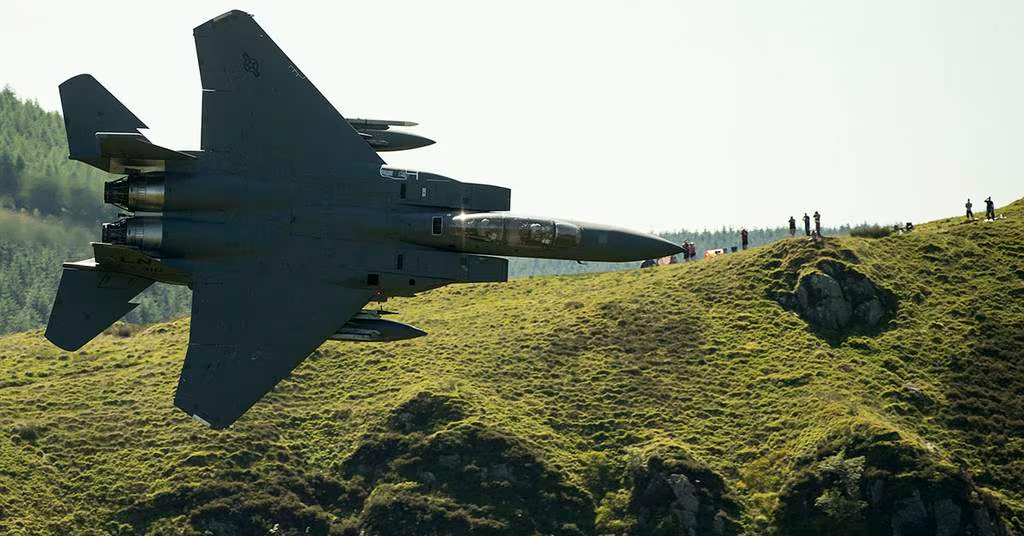Breaking News: Aging Fighter Jets to Work in Sync with Newer Generation Planes
In a groundbreaking development, aging fighter jets will now be able to work seamlessly with newer, fifth-gen and soon-to-be sixth-gen aircraft. Despite the impressive progress in the research of new platforms, these older flying weapons systems are expected to remain in use for at least another four decades. This integration is crucial for maintaining a cohesive and efficient fighting force.
The era of fighter jets began in the 1940s during the conflict years. Experimental planes such as the Messerschmitt Me 262, MiG-9, and Lockheed P-80 Shooting Star marked the first generation of these remarkable machines. These aircraft not only revolutionized air combat but also played a significant role in propelling mankind into the space age.
Following the initial generation, the Korean War introduced the world to the likes of the North American F-86 Sabre, MiG-15, and the Dassault MD.454 Mystere IV. These second-generation planes brought forth new engine designs and advanced tracking and strike capabilities, further enhancing the capabilities of fighter jets.
The third generation of fighter jets emerged in the mid-1950s, featuring iconic aircraft such as the American F-4 Phantom II, Russian MiG-23, and French Mirage F1. These versatile machines served both fighter and bomber roles, thanks to improved engines and state-of-the-art electronics.
Subsequently, the fourth generation of fighter jets took center stage and continues to be in use today. Examples of these aircraft include the F-16 Fighting Falcon, F/A-18 Hornet, MiG-29s, Sukhoi Su-30, and Eurofighter Typhoon.
The latest addition to the fighter jet family is the fifth-generation aircraft, with only four models currently dominating the skies worldwide. These include the F-22 Raptor, F-35 Lightning, Chengdu J-20, and the Su-57. Furthermore, ongoing efforts are being made to develop two sixth-generation aircraft, namely the American Next Generation Air Dominance (NGAD) and the European Global Combat Air Program.
Despite the significant advancements made in military aviation over the past six decades, integrating older aircraft with newer ones remains a challenge. Defense contractor Lockheed Martin, however, claims to have the solution: the Sniper Networked Targeting Pod.
Originally deployed on fourth-gen fighters, this pod acts as an add-on that allows aircraft to share critical data about targets and threats with other planes. Equipped with an electro-optical sensor system, the pod connects aircraft and other military equipment through a high-speed datalink, operating at 5G speeds.
Thanks to an innovative transformation, the Sniper Networked Targeting Pod has been turned into an “edge communications and computing node.” This groundbreaking technology seamlessly integrates F-35s, F-16s, and ground-based artillery systems, such as HIMARS, MRLS, and European mobile rocket launchers, into a single network. This network enables efficient data sharing and surveillance among its members, enhancing overall operational effectiveness.
With the introduction of the Sniper Networked Targeting Pod, the military is one step closer to achieving a unified fighting force that incorporates both older and newer generation aircraft. This breakthrough technology will undoubtedly revolutionize the way fighter jets operate, ensuring the continued dominance of air power for years to come.
Lockheed Martin has announced a new capability for its Sniper Networked Targeting Pod that could greatly enhance ground-based artillery systems. This development would allow these systems to receive a continuous and reliable stream of data from aircraft flying overhead, turning fighter planes into forward observers for both other planes and ground troops. The improved precision of strikes, even if the target changes position, is expected to be a significant benefit.
The Sniper pod has already undergone testing with HIMARS and GMLRS, but further flight testing and live missile shots are still required. It is unclear how long these tests will last and when the upgraded Sniper pod will be ready for integration in NATO airplanes. However, the system’s plug-and-play design should make it relatively easy to upgrade fourth-generation aircraft and fit fifth-generation aircraft with the pod.
The current version of the Sniper pod is already deployed on numerous F-16s and various other fighter jets in Europe. Combined with the pods installed on American aircraft, the Sniper has accumulated over four million operational hours, proving its effectiveness in combat and intelligence, surveillance, and reconnaissance missions.
Lockheed Martin is now looking to the future and plans to use the Sniper pod to connect with other systems it produces. This includes the SkyKeeper air-defense system and the hypersonic Mako missile. The adaptability of the Sniper pod to connect different weapons platforms makes it a valuable asset for the company’s evolving technology.
Overall, the new capability of the Sniper Networked Targeting Pod has the potential to greatly enhance the effectiveness of ground-based artillery systems. Lockheed Martin’s continued development and integration of this technology across various platforms demonstrate their commitment to advancing military capabilities.












